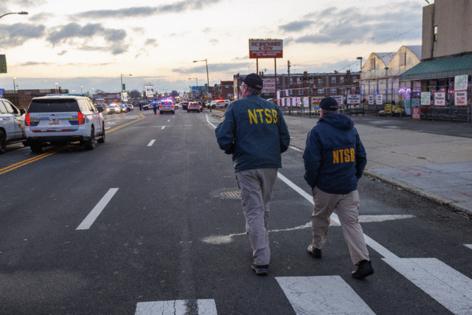'It looks like a rocket': What we know about the ambulance jet that crashed in Philly
Published in News & Features
PHILADELPHIA — Something catastrophic had to happen for the pilots of a Learjet 55 to lose control so soon after takeoff from Northeast Philadelphia Airport on Friday night, turning an air ambulance into a fuel-laden rocket that nose-dived into the ground near the Roosevelt Mall, aviation experts say.
Whatever went wrong, it was likely beyond human control.
“This happened so fast. These guys, I’m sure, were totally surprised by it,” Arthur Alan Wolk, a Philadelphia-based aviation attorney, said of the pilots. Wolk flies an aircraft of similar size and speed out of Northeast Airport.
Several aviation experts consulted by The Inquirer cautioned that it will take a full investigation by the National Transportation Safety Board to pinpoint the cause of the crash that killed all six people aboard and one person on the ground.
But the near-45-degree angle of descent as the jet barreled toward Cottman Avenue at 235 mph indicates the two pilots aboard were powerless to maneuver the hurtling aircraft.
“It looks like a rocket that comes straight down,” said David Evans, an airline transport pilot and flight instructor. “Even a Lear has some sort of glide capability. It just looks so highly unusual.”
The aircraft that crashed in a fiery, rush-hour explosion was one of the workhorses in the medical transport fleet of Jet Rescue Air Ambulance.
Built in 1982, the 43-year-old twin-engine jet had made 73 flights, landing in 43 cities, across the United States, Canada, Mexico, and other countries over the last three months, with 11 flights in the last week. The air ambulance is owned by a Mexican entrepreneur with three previous crashes on record — the most recent in 2023, when five people died in Mexico after a pilot overran the runway.
In investigating Friday’s crash, the National Transportation Safety Board will explore each layer of potential causation, including the jet’s maintenance history, engine failures or other mechanical problems, pilot training, fatigue, or even incapacitation. The weather conditions, weight balance, and the role of air traffic control will also come into play.
In the 24 hours before the crash, the jet flew to three cities and two countries that investigators will need to gather information from. The NTSB will also seek records from the Mexican government on the aircraft’s entire maintenance history, its owners, and its crew.
“Everyone kind of needs to take a deep breath,” said J.F. Joseph, a retired U.S. Marine Corps colonel and the operator of Joseph Aviation Consulting. “Let the facts lead us to conclusions rather than speculation driving the theories around.”
While the Learjet 55 is an older model, the experts agreed, it is still in wide use and is considered reliable, well-suited for medical transport because it is large enough to carry multiple passengers and medical equipment, can travel long distances, and fly at fast speeds and high altitudes to move patients quickly from one city to another.
Age and extensive use alone are not necessarily a concern for a well-maintained Learjet.
“There are other airplanes out there that are 43 years old and flying,” Wolk said. “… The problem with 43-year-old airplanes is they break more often than airplanes that are newer.”
After watching video of the jet’s near 45-degree angle of decent, Wolk said the odds are that the problem began when the autopilot was turned on, typically around 500 feet after takeoff.
“There are two separate sets of instruments, one for each pilot, and this particular flight and these particular weather conditions were really a no-brainer, certainly not difficult for a Learjet pilot,” he said.
Wolk believes that since the plane was obliterated on impact, leaving fewer clues, and the pilots did not communicate with air traffic control during the crisis, a key for crash investigators could be on the cockpit voice recorder. “Presumably the crew would have said something to themselves when this started to happen.”
Barry Rothman, a retired U.S. Air Force senior pilot and former Federal Aviation Administration safety counselor who has flown Learjets and has years of experience at Northeast Philadelphia Airport, zeroed in on the lack of communication as a sign that the pilot was consumed with the lack of flight control.
“I can’t imagine him not fighting the airplane to pull the nose up,” Rothman said.
Rothman was reluctant to speculate on the causes. “The only thing that I’m questioning in my mind is a flight control malfunction,” he said. “Whatever controlled the elevator, a cable snapped?” Other factors like weight balance, critical for an aircraft to fly safely, seemed less likely to him.
“Is that a possibility? It is, but with only six passengers, presumably in the center of the cabin, it’s hard to imagine their center of gravity was off.”
Flight-path data show the aircraft reached 1,650 feet at 218 knots before it began descending less than a minute after it was first tracked leaving the airport. Air traffic control audio appears to indicate the plane was cleared for a routine departure, followed by a quick loss of radio contact.
A growing medical flight business
Jet Rescue Air Ambulance, which is incorporated in Boca Raton, Florida, under the name Med Jets USA Inc., is the brainchild of entrepreneur Carlos Salinas Trevilla, who has operated two different medical flight services over the years.
Trevilla studied to be a paramedic at Southwestern College in California in the 1980s, according to an online resume, and volunteered with the Red Cross in Mexico. He was trained as a pilot and flew helicopter paramedic flights during the 1995 Mexico City earthquake, according to the Chicago Tribune.
He founded his first air ambulance company, known as Global Life Flight, in 1998, which provided similar international emergency flights using Learjets, sometimes serving as a subcontractor for American-based medical transport companies, according to a lawsuit over a financial dispute.
In 2007, he formed a new company, known as Med Jets S.A. de C.V in Mexico City, which would be publicly marketed as Jet Rescue Air Ambulance.
Among Jet Rescue’s offered roles is neonatal and critical-care pediatric transport, as was the case in Friday’s crash, which included a girl from Shriners Children’s Philadelphia. The child and her mother were among the seven killed in the crash, including one person on the ground.
In 2018, Trevilla also formed a Mexico-based security firm, known as Blackwater Global Protection, which provides bodyguard services and private jets aimed at executives and other VIPs.
According to Florida corporation records, Trevilla spun off his U.S.-based subsidiary of Med Jets in that state in 2016. Florida Department of Health records show that the company had three aircraft licensed for medical transport this year — including the plane that went down in Northeast Philadelphia.
He appears to have had recent ambitions of broadening the company, forming a new corporation, known as Med Jets International, with his wife in Florida in 2023.
Over the course of nearly 30 years and thousands of flights, Trevilla’s companies have had a few other emergency incidents.
According to a 1998 report in the Associated Press, a Global Life Flight pilot was forced to make an emergency landing in Dickinson, South Dakota, after his engine burst into flames at 41,000 feet. The plane, which was transporting six people from Guatemala to Regina, South Dakota, for a medical procedure, landed without injuries to those aboard.
In 2019, during a takeoff from Toluca Airport in Mexico, a Jet Rescue Learjet 35 sustained an issue with its braking system as a result of another fire. That flight, bound to retrieve organs for medical use, also landed successfully.
But, in 2023, five people died on another Jet Rescue flight, near the town of Tetlama, Mexico, after the pilot overran a runway and crashed into a wooded hill.
©2025 The Philadelphia Inquirer. Visit inquirer.com. Distributed by Tribune Content Agency, LLC.







Comments